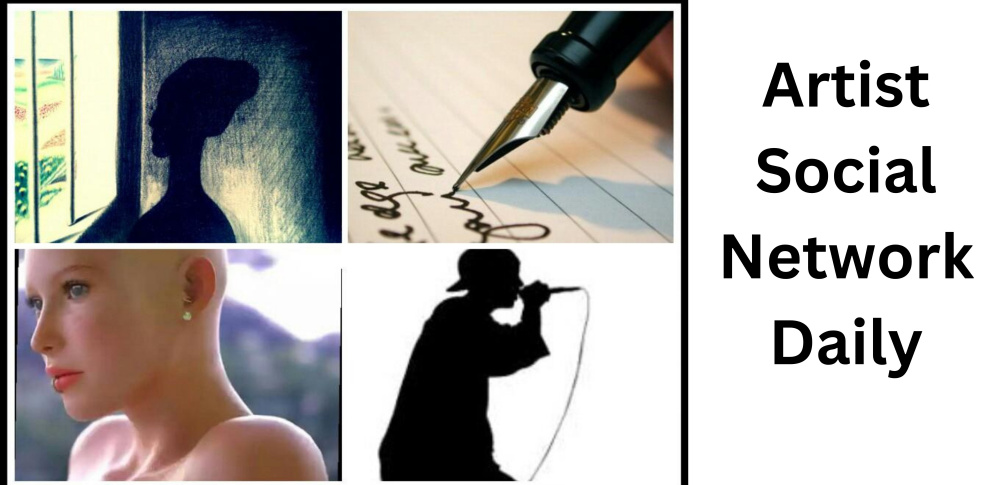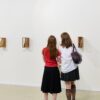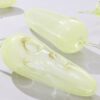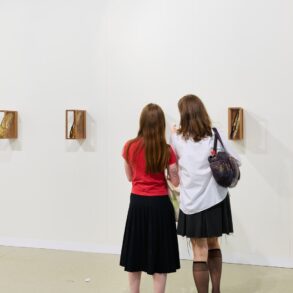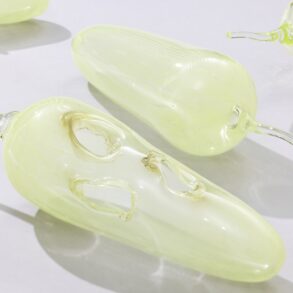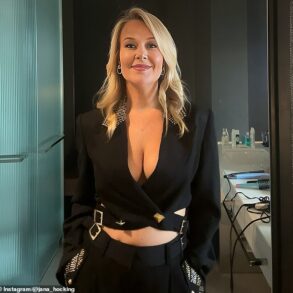GRAND FORKS — When bombs started dropping in February 2022 in Kharkiv, the second largest city in Ukraine, Olia Fedora sought shelter in her cellar. The shelling continued daily for months while many of the city’s residents fled. Some, like Fedora, stayed. She was 28 at the time and is the youngest artist in “Women at War,” a traveling exhibition that’s on display at the North Dakota Museum of Art in Grand Forks.
“Women at War” shares the stories of 12 female Ukrainian artists who have survived wars in their homeland. The show originally opened in July 2022 in New York, just a few months after the Russian invasion of Ukraine began, and was listed as one of the top 10 exhibitions of that year by the Washington Post and Frieze Magazine.
ADVERTISEMENT
Anna Paige / The Forum
Fedora wrote a series of 10 poems, what would become her “Tablets of Rage,” while sheltering in place. She used materials at hand and wrote the work on bed sheets with a felt pen before she left Kharkiv for Austria as a refugee in May 2022.
“May you choke on my soil.
May you poison yourself with my air.
May you drown in my waters.
May you burn in my sunlight.
May you stay restless all day and all night long.
And may you be afraid every second.”
ADVERTISEMENT
When reading this poem aloud during a gallery talk on Thursday, Feb. 27, at the North Dakota Museum of Art, Monika Fabijanska, curator for “Women at War,” paused before the last line. The words caught in her throat as she held back tears.
Anna Paige / The Forum
“Olia Fedora lost her home and her whole network of friends, family — the whole ecosystem that supported her — which resulted in her losing herself in the following years,” Fabijanska said during the talk. Fedora felt abandoned, Fabijanska described, so she wrote these poems, which unfold as prayers, spells and curses.
At first, she described her fear. What comes later is her fury.
Anna Paige / The Forum
“Fedora is also the artist of the most personal work for me in this exhibition,” Fabijanska said. “I was in touch with her during all these weeks. I was in touch with all these women.”
Fabijanska is based in New York and describes herself as a feminist and a pacifist, so when she was asked to curate a show for the Fridman Gallery in Manhattan’s lower East Side focused on the war in Ukraine, she thought, “What do I have to say about the war?”
“I thought it was impossible for me to even grapple with,” Fabijanska said. Yet, such an opportunity pulled her directly into the topic. Her background in various feminist art movements and art history propelled her to find female artists in war-torn countries and help them tell those stories.
“It was an immediate realization that we need to tell a story,” said Fabijanska. “We need to bring something that would allow people here to understand why Ukraine wants to have their own statehood.”
ADVERTISEMENT
Fabijanska doesn’t shy away from difficult topics (for an earlier exhibition, “The Un-Heroic Act: Representations of Rape in Contemporary Women’s Art in the U.S.,” she brought together the works of 20 female artists across four decades that depict the experience of rape), but she was frank about how much the exhibition impacted her. When asked by an audience member if she planned a second installation, she said, “I hope that we’ll never have to organize an exhibition about war again.”
After the exhibition closed in New York, universities and other public facilities hosted the show, including Stanford’s art gallery in Washington, D.C. “Women in War” made its way to the Midwest with stops in Chicago, Manitoba and Grand Forks, where it will be on display through March 30.
Anna Paige / The Forum
“The power of this exhibition … is its ability to capture the complexities and contradictions, and fully capturing the experiences of the war,” said Anna Sigridur Arnar, North Dakota Museum of Art’s curator of modern and contemporary art. “As Alina Brown, one of the artists in the exhibit, stated, ‘There are no winners or losers of the war, only survivors.’”
Adam Kemp of Grand Forks has returned to the exhibition several times, bringing his daughter, Hanna, who has special needs, as well as several of his friends.
“I’m a European, so when people say Ukraine to me, I don’t think of a land across the sea. It’s connected to all of us,” Kemp said. “And when I hear some Americans talking about it as if it doesn’t really affect them, I’m just like, ‘Yeah, no.’ It’s the beginning of a massive failure if we let it fall … This is not something that’s unattached to us.”
Anna Paige / The Forum
Kemp’s daughter has been particularly intrigued by Zhanna Kadyrova’s “Palianytsia,” which gets its name from the Ukranian word for large-sized round wheat bread. It’s also a word that is difficult for Russians to pronounce, and when Ukraine was invaded by Russian troops in February 2022, this word became a way to distinguish Ukranians from invading forces.
Kadyrova, who fled to Transcarpathian in western Ukraine’s Carpathian mountains, found river rocks shaped like traditional Ukranian bread and cut them to embody the ideas of resistance and identity in times of war.
ADVERTISEMENT
Anna Paige / The Forum
“Given that the media is dominated by the antics of poisonous males right now, to come here and see intimate stories of the way a very territorial war is playing out — but from the point of women — it’s actually a breath of fresh air because it’s anti-propaganda,” Kemp said. “This is people being resourceful in desperate times, being creative.”
For the exhibition, Fajijanska connected with women like Dana Javelina, a refugee living in Berlin who is from Melitopol in southeastern Ukraine. Javelina focused on women victims of war who were purposefully and repeatedly raped in her artworks. Her drawings depict childbearing, rape as a weapon, and women as vessels for communities that have been destroyed by war.
Anna Paige / The Forum
Anna Paige / The Forum
Kateryna Yermolaeva, who lives and works in Kyiv, tells her story in self-portraits. The artist grew up in Donetsk, which was captured by separatists supporting Russia in 2014, and she was alienated from her home and family and began experimenting with her identity through non-binary characters as a response to crisis triggered by war. “Rapidly, I began to lose myself as an artist,” she said in the exhibition text.
With ink on paper, Alevtina Kakhidze illustrates an ode to her mother, “Strawberry Andreevna,” in a devastatingly personal narrative. ” The project, named for Kakhidze’s mother, depicts the story of her daily life in southeastern Ukraine during the time that Russian-basked separatists seized power in Donetsk, proclaiming the city as the Donetsk People’s Republic and claiming it as an independent state. Her mother, who was among a half million Ukrainian retirees registered as displaced persons in Ukraine, died in 2019 after suffering a cardiac arrest while crossing the line between the self-proclaimed DPR and Ukraine to collect her pension, according to the artist.
Anna Paige / The Forum
“I never imagined this would be my role,” said Fajijanska. “Curating is about making friends with other people. Even if this exhibition didn’t bring so many things to my life, it brought (new people) to my life, and I’m grateful for this.”
This post was originally published on this site be sure to check out more of their content
